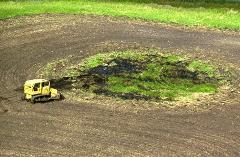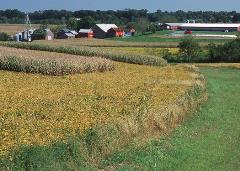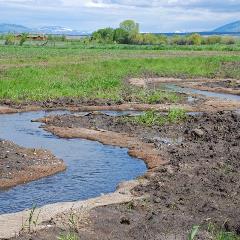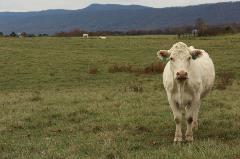Duane Hovorka, IWLA Agriculture Program Director
The Senate passed its Farm Bill in June on an 86-11 vote, reflecting broad bi-partisan support for the Senate approach to the bill. The House passed its Farm Bill in June on a 213-211 vote, several weeks after failing to pass an identical bill. The narrow vote in the House – in which 20 Republicans and nearly every Democrat voted against the bill – reflects important disagreements over the approach to nutrition programs, targeting of commodity program benefits, conservation programs, and add-on provisions that would weaken important clean water, public land, and endangered species laws.
The League’s position on Farm Bill conservation issues highlights the many differences between the Senate and House bills. Here are five key issues that could determine whether the final Farm Bill is a “win” or “loss” for fish, wildlife, and water quality.
1. Funding and Effectiveness
 With the huge demand for Farm Bill conservation programs, Congress should provide at least full funding for the Conservation Title and ensure the funds result in even greater benefits for our natural resources. The Senate bill maintains funding for conservation programs in the Farm Bill, although it does not provide for an increase. The House bill would cut spending on Farm Bill conservation programs over the next 10 years, diverting the funds to more generous commodity payments to farmers, trade, and other programs.
With the huge demand for Farm Bill conservation programs, Congress should provide at least full funding for the Conservation Title and ensure the funds result in even greater benefits for our natural resources. The Senate bill maintains funding for conservation programs in the Farm Bill, although it does not provide for an increase. The House bill would cut spending on Farm Bill conservation programs over the next 10 years, diverting the funds to more generous commodity payments to farmers, trade, and other programs.
However, the House bill would earmark up to 1% of conservation program funds to assess and evaluate program results, which should help boost the conservation benefits of each dollar spent. The House bill would also boost funding for conservation easements that restore and protect wetlands and native prairies from development to $2.5 billion over five years, an increase from the current Farm Bill ($2.025 billion over five years). The Senate bill includes a smaller increase to $2.075 billion over five years.
2. Conservation Reserve Program
 Both bills would increase the size of the Conservation Reserve Program (CRP) from its current base of 24 million acres: to 25 million acres in the Senate bill or 29 million acres in the House bill. Both bills would fund the acreage increase by cutting CRP payments to farmers who enroll in the program. Both bills would make it more difficult to convince farmers to set aside a portion of a field to restore small wetlands or plant buffer strips, filter strips, and windbreaks. However, the House bill would cripple the ability to use the program to restore polluted streams, lakes, and wetlands through these best practices.
Both bills would increase the size of the Conservation Reserve Program (CRP) from its current base of 24 million acres: to 25 million acres in the Senate bill or 29 million acres in the House bill. Both bills would fund the acreage increase by cutting CRP payments to farmers who enroll in the program. Both bills would make it more difficult to convince farmers to set aside a portion of a field to restore small wetlands or plant buffer strips, filter strips, and windbreaks. However, the House bill would cripple the ability to use the program to restore polluted streams, lakes, and wetlands through these best practices.
The House bill would cap CRP base rental rates paid to farmers at 80% of county dryland rental rates, reducing the payment landowners would get when enrolling cropland in the program. When landowners re-enroll, they would get even less with each subsequent contract. The House bill would eliminate incentive payments and reduce the cost-share paid to landowners that reimburses them for a portion of the cost of planting vegetation on the land enrolled. Altogether, many landowners would be offered less than half of what they now receive to enroll land in the program and far less than they could get renting out their environmentally sensitive land or continuing to farm it.
The Senate bill would cap CRP rental rates paid to farmers at 88.5% of county dryland rental rates and eliminate incentive payments in periods when crop prices are below long-term averages (which means now and for the foreseeable future). The Senate bill would prioritize water quality measures such as buffer strips, filter strips, and wetland restoration plus wildlife practices designated as state priorities, but it isn’t clear that farmers would be willing to enroll land in those practices at the payment rates contemplated in the bill. The Senate bill would create a much-needed conservation reserve easement option that would be available for expiring CRP contracts starting in 2029. Farmers with CRP contracts would also have more flexibility to hay or graze their CRP land.
The League continues to argue for modest changes to CRP that will achieve cost savings but increase the U.S. Department of Agriculture’s (USDA’s) ability to use the program to address water quality problems that plague so many rural areas.
3. Crop Insurance
 Taxpayers pay billions of dollars each year to subsidize crop insurance premiums for farmers and to pay insurance companies to sell and service crop insurance policies. The Senate bill would give USDA authority to offer a “good farmer discount” for farmers using practices that reduce the long-term risk of a crop loss, including measures that build soil health like planting cover crops and using more diverse crop rotations.
Taxpayers pay billions of dollars each year to subsidize crop insurance premiums for farmers and to pay insurance companies to sell and service crop insurance policies. The Senate bill would give USDA authority to offer a “good farmer discount” for farmers using practices that reduce the long-term risk of a crop loss, including measures that build soil health like planting cover crops and using more diverse crop rotations.
The League has been a champion of this approach, which would be good for farmers, soil health, water quality, and taxpayers. The bill would also ensure that farmers who follow USDA recommendations for planting cover crops would not jeopardize their crop insurance coverage because they planted cover crops. The House bill does not include either of these important provisions.
4. Working Lands
The two bills reflect very different approaches to programs that help farmers and ranchers be better stewards of cropland and grazing land. The House bill would eliminate the Conservation Stewardship Program (CSP), USDA’s largest conservation program, which rewards farmers who adopt high-level conservation systems, takes a “whole farm” approach to conservation, and requires that farmers achieve minimum levels of conservation. The House bill would divert some of those funds to the Environmental Quality Incentives Program (EQIP), which takes more of a field-by-field and resource-by-resource approach to conservation. EQIP funds can also be used to build large feedlot lagoons and install expensive irrigation systems that deliver few environmental benefits.

The Senate bill would keep both the Conservation Stewardship Program and the Environmental Quality Incentives Program in place while reducing the size of both programs to boost funding for other conservation programs. The Senate bill would also increase the share of EQIP dollars earmarked for wildlife habitat from 5% to 10%.
The Senate bill would also add $100 million per year to the Regional Conservation Partnership Program, which leverages state and local funding to focus conservation dollars on a short list of highly effective solutions at a scale where they will make a real difference in watersheds or areas where they are most needed. The Senate bill would also make the program more flexible and responsive. The House bill includes neither an increase in funding nor the reforms needed to substantially improve the program.
5. Environmental Protections
Some of the most controversial provisions in the House bill would change laws that are outside the Farm Bill. For example, the House bill would repeal the Clean Water Rule that clarifies which waters are covered by the Clean Water Act, eliminate a requirement that the U.S. Fish and Wildlife Service be consulted with respect to the impact of pesticides on wildlife when registering pesticides, and change federal law to prevent a state or the U.S. Environmental Protection Agency from protecting state waters from the discharge of pesticides. The Forestry Title of the House bill also includes many Categorical Exclusions which would reduce or eliminate public review and participation in Forest Service management decisions for large pieces of our National Forests, including the clearcutting of trees to increase runoff from Forest Service lands, expediting salvage operations, making way for roads or bridges, and other purposes.
Focusing on Impact
There are many more issues and programs in the Farm Bill that directly impact our soil, air, woods, waters, and wildlife. Yet these five issues – funding and effectiveness, Conservation Reserve Program, crop insurance, working lands programs, and extraneous amendments to other conservation laws – will have a huge impact on the health of America’s rivers, lakes, wetlands, and wildlife over the next five years.
To weigh in with your members of Congress on the Farm Bill, visit our online Advocacy Center. For more information about the draft bills, read our summary of the key Farm Bill Conference Committee issues (PDF link).